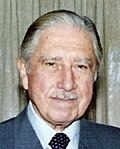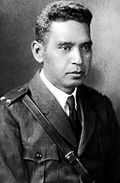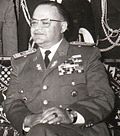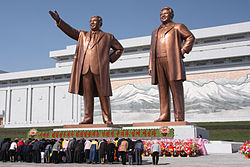Dictatorship
A dictatorship is a form of government, where one person effectively has all the power to run a country without having elections. This person is called a dictator. In very few cases, a small group of people holds this power, which is called an oligarchy.[1] A dictatorship that is ruled by soldiers is called a military dictatorship or junta. An absolute monarchy (the system where there are Kings and Queens who have full power over their country) can be considered to be a dictatorship, but the people are usually not called dictators.[2]
Roman dictators were temporary rulers appointed to protect the state during a war or other emergency. Many countries have laws that allow a similarly time-limited dictatorship, to fight against such problems. Karl Marx has the idea of the Dictatorship of the proletariat. When they became independent in the 1960s and 1970s, many African states changed to be dictatorships, run by one person. Karl Popper distinguished between two different forms of government, "Those where it is possible to change the government without bloodshed, in a popular vote, and those where it isn't." He said that this was the key difference, and not how the forms of government are named.
Dictators often come to power in times of difficulty, such as massive unemployment, inflation, and unrest among the population. Dictators are normally backed by powerful groups, such as landowners, private company owners, bank owners and in some cases institutions like the Roman Catholic Church to put in place law and order by force. This force may be directed at the poorer parts of society, such as unemployed workers, ethnic minorities, working class areas and shanty towns. Examples of this are the dictatorships in Latin America and the prosecution of the Jewish community in 1940s Germany.
Dictators normally need to do a number of things to put in place their dictatorships: they need to get rid of their opponents (which may be political or religious) - some are imprisoned, exiled (sent outside their country) or killed. Dictators will then need to prohibit (or not allow) political parties that oppose their rule. They will confiscate (take away) the political parties' property or offices and such things. Dictators may suppress or persecute some religious groups or institutions. Dictators will also need to undo or close down democratic institutions such as parliament and in some cases the congress.
Some social organizations, such as civil rights groups, human rights organisations, legal aid centers, students' unions, teachers' federations, trade or workers unions are also undone and those who persist with such activities may be imprisoned or killed. Dictators often rewrite an existing constitution or put in place a completely new one. This makes their power constitutional (which then cannot be disputed). Dictators then maintain their rule with state terrorism, which normally involves a secret police, death squads, random or night curfew, indefinite arrest without trial and a network of torture centers and concentration camps. Some dictatorships create a fictional (or non existent) internal (inside their country) enemy which they claim to be at war with to justify (give reason for) their use of much military violence against their people.
Recent dictators
Africa
Latin America
Augusto Pinochet ruled Chile as a dictator from 1973 to 1990. There were widespread reports of torture, and people regularly disappeared. Pinochet also made beneficial economic reforms. He put economists in key positions. After a popular vote, Chile returned to democracy, with free elections in 1990. There also were reports on corruption, and Pinochet wanting to evade taxes.
Alfredo Stroessner ruled Paraguay as a dictator from 1954 to 1989. During his reign, there were widespread reports of human rights abuses, like kidnappings, regular disappearances of people, extrajudicial killings and even ethnic cleansing.
Jorge Rafael Videla ruled Argentina as a dictator, from 1976 to 1983. There were large-scale human rights abuses during his reign.
Maximiliano Hernandez Marinez ran El Salvador from 1933 to 1966.
Guillermo Rodriguez Lara ran Ecuador from 1972 to 1977
Asia
Europe
Countries often described as dictatorships
The following countries are described as dictatorships:[3]
Americas
Partially recognised or unrecognised states
Dictatorship Media
Benito Mussolini in the March on Rome that installed him as dictator in Italy
Soldiers occupy Seoul, South Korea, as part of the May 16 coup that placed General Park Chung Hee in power.
An assembly at the Kremlin Palace of Congresses in Moscow, Soviet Union
Citizens of North Korea bow to statues of former dictators Kim Il Sung and Kim Jong Il in 2012.
- Stans08-036 (3134870208).jpg
The rotating statue of Saparmurat Niyazov in Turkmenistan
The Nuremberg rallies celebrated fascism and the rule of Adolf Hitler in Nazi Germany.
Statue of Stalin in East Berlin, 1951. It was removed in 1961 as part of de-Stalinization.
Mobutu Sese Seko, Zaire's longtime dictator
Related pages
References
- ↑ "Dictatorship - an overview | ScienceDirect Topics". www.sciencedirect.com. Retrieved 2021-06-21.
- ↑ "dictatorship | Definition, Characteristics, Countries, & Facts". Encyclopedia Britannica. Retrieved 2021-06-21.
- ↑ "Dictatorship Countries 2023".











